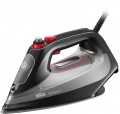Power consumption
The power consumed by the device during operation.
In general, more powerful models are considered more advanced — at least because the high power speeds up the time to heat up to operating temperature and allows you to achieve higher steam performance. On the other hand, such power significantly affects the dimensions, weight and price.
Among classic irons, power up to 1500 W corresponds to the entry level, it is mainly typical for travel models. An indicator of 1500 – 2000 W is considered average, and values of 2000 W and more are typical mainly for professional devices. In the presence of a steam generator, the power increases noticeably, and among ironing systems and presses there are models with a power of up to 6 – 7 kW.
Steam boost power
The steam power supplied by the iron in boost mode.
The steam power is the amount of steam the iron produces per minute. See above for more information on the general meaning of this parameter. And the steam boost mode is a mode of enhanced steaming, when the iron practically “shoots” with a boost of steam; "shot" is usually made by pressing a special button. Steam boost allows you to achieve an intense effect that is not available with conventional steaming; such an impact can be useful, for example, to smooth out heavily rumpled fabrics that would be difficult to deal with in other ways.
A steam boost of 100 g/min or more is said to be sufficient to handle most tough and "unruly" materials. And
models with a powerful steam boost from 200 g/min will definitely not leave even the most dense fabric rumpled. However, there are models with more modest indicators — they are quite suitable for those who need an iron for ordinary household ironing. Moreover, high power, usually, affects the cost. Do not forget about irons with a steam generator, where the performance values are higher, since the purpose of the iron is slightly different.
Iron weight
The total weight of the iron. Usually, this parameter is indicated "dry", without water; and for steam generators and ironing systems (see "Type"), the weight of the iron is given, without additional equipment.
Initially, it was believed that the heavier the iron, the more efficiently it performs its task. However, modern models use various technical tricks to achieve good ironing quality with low weight. At the same time, a lighter iron is more “manoeuvrable” and easier to use, you can work with it for a long time without getting tired. Therefore, it makes sense to specifically look for a massive model only in cases where you plan to often work with difficult-to-iron, “unruly” fabrics — for example, natural linen: more weight will give additional processing efficiency.
System weight
The total weight of the steam iron or ironing system (see "Type"). Usually, the dry weight is indicated in the characteristics, excluding the filled water.
It makes sense to pay attention to this parameter if ease of transportation is important to you: the lighter the weight, the easier it is to transfer the structure from place to place. On the other hand, light models usually either cost more than heavy ones or have a smaller water tank capacity.

